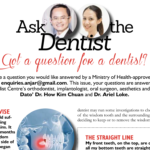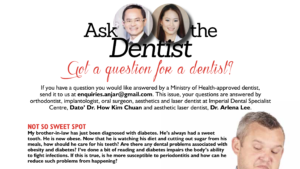“Are there certain times when gum disease is more likely to occur?”
Although gum disease occurs more frequently with advancing age, even children can be affected. For example, gingivitis is common during the teen years because of the hormonal changes that occur during puberty. Likewise, hormonal changes during pregnancy cause 30 to 60 percent of pregnant women to experience red, tender or bleeding gums. If gum disease has been present in either of these groups before hormonal changes, the symptoms may become even more severe or harder to control. Lifestyle and health problems can also increase risks. An inadequate diet and stress can interfere with your body’s ability to fight infections, including a gum infection. Smoking and tobacco use irritate the gums, increasing the risk of gum disease. Diseases such as leukemia or AIDS can increase the risk of getting gum disease because the body’s protective immune system does not function properly. Also, if you have conditions that make you more prone to infections, such as uncontrolled diabetes, gum disease can be more severe or harder to control. Be sure to tell your dentist about any conditions you have or medications that you take. Some drugs, such as oral contraceptives, antidepressants, anticonvulsants and certain antihypertensive medications, can affect your oral health.
“How can the dentist tell if I have gum disease?”
When you go for regular dental visits, your dentist will check your mouth for any disorders, including gum disease. He or she will inspect the color and firmness of the gums and check your bite. A thorough dental examination will include using a small instrument, called a periodontal probe, to measure the depth of the space between the tooth and gum. This will determine whether you have periodontal pockets. Generally, the more severe the gum disease, the greater the depth of the pockets. Complete dental x-rays may also be taken to evaluate the bone supporting the teeth and to detect other problems not visible on clinical examination.
“What can I do to prevent gum disease?”
Except in rare cases, gum disease can be prevented by thorough daily plaque removal by brushing, cleaning between teeth with floss or inter dental cleaners, eating a balanced diet and by regularly visiting your dentist for professional cleanings. When plaque is not removed, it hardens into a rough, porous deposit called tartar. Once tartar forms, it can only be removed by a dental professional. That’s where regular dental visits come in.
Your dentist or hygienist will remove tartar, using hand instruments or an ultrasonic machine which helps vibrate the tartar off. During dental visits your dentist or hygienist can give you tips on the proper way to brush and floss and recommend a personalized oral home care program to meet your specific needs. They can also give you advice on selecting dental products that will work best for you. If you need extra help in controlling plaque, they may recommend that you rinse with an antimicrobial mouth rinse as an adjunct to your daily brushing and flossing. In choosing dental products, look for the ADA Seal of Acceptance or Recognition. The seal represents a scientific review of the product by the ADA, and is your assurance that the product has been proven safe and effective.
“How is gum disease treated?”
One key to successful treatment of gum disease is the thorough daily removal of plaque from the teeth at home. You may be instructed in the proper way to brush and floss, and if you have special needs, you may be advised to use additional aids. The early stages are usually treated by a procedure called scaling and root planning, in which your dentist and hygienist remove tartar from the teeth.
Once the bacteria and toxins that irritate the tissue are eliminated, the gum can often reattach to the tooth or shrink enough to eliminate the pocket. If gum disease is caught in the early stages, professional cleaning, combined with good oral hygiene and diet, is often enough to restore oral health.
In the more advanced stages of gum disease, a variety of treatment techniques may be necessary. These can include gum surgery to remove tartar from deep pockets and to regenerate lost gum and bone. Depending on the situation, bite adjustment, bridgework, dental implants and orthodontics may also be recommended. The recommended treatment is tailored to the individual’s particular needs and goals.“Who performs periodontal treatment?”
All dentists are taught to recognize and treat the early stages of gum disease. If your dentist thinks you should see a specialist for treatment, he or she will refer you to a periodontist. Periodontists are dentists who specialize in treating gum disease and have had additional training in this area.
You now have some of the answers to questions about periodontal disease. If you have more questions, contact your dentist. He or she can talk with you about your particular dental problems and recommend treatment that is right for you.
|








